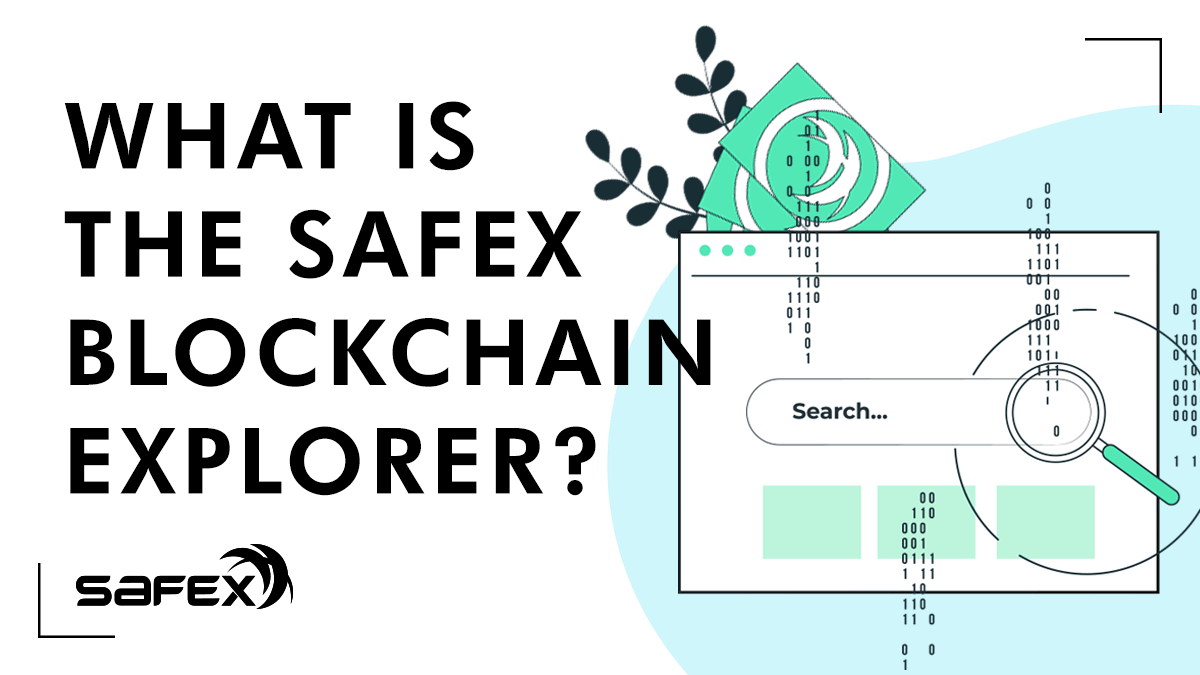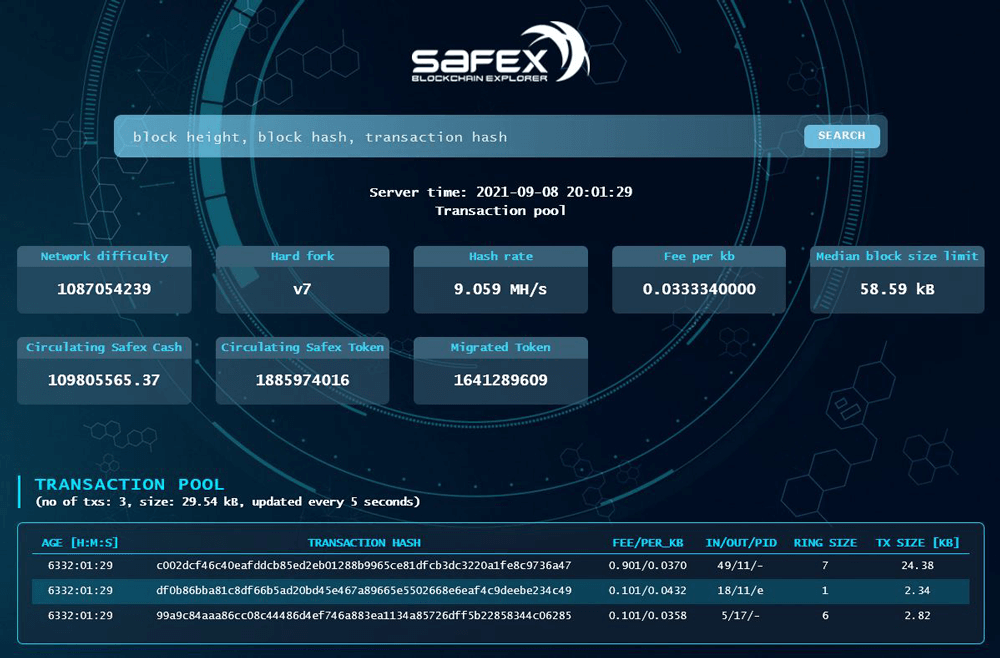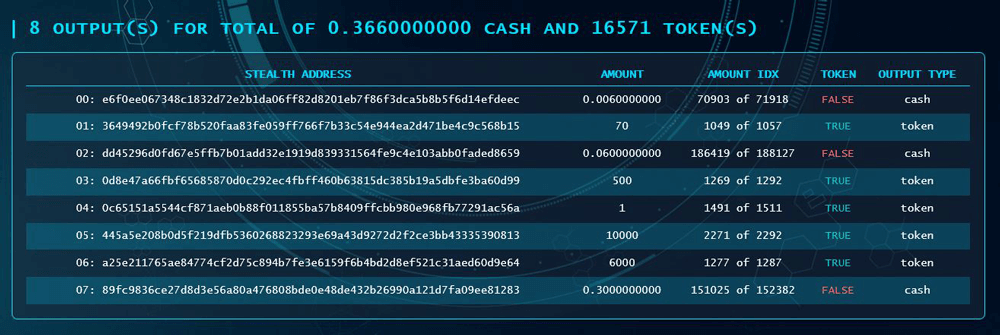What is the Safex Blockchain Explorer?
Learn what the Safex Blockchain Explorer is, and how to use it.

A blockchain explorer, or more commonly referred to simply as a block explorer is a website that provides access to publicly visible information about that specific blockchain. The Safex Block Explorer can be found at explore.safex.org. It provides a table displaying the following information:
- Network Difficulty
- Hard Fork version
- Network Hashrate
- Fee per kb (transactional data cost)
- Median Block Size Limit
- Circulating Safex Cash
- Circulting Safex Token
- Migrated Token
It also shows a Transaction Pool table (pending transactions awaiting processing) and a Transactions/Block Height table, which is a catalogue of every block, in chronological order, along with the corresponding transactions that were processed in each block.
Because Safex is a Privacy Blockchain that utilises stealth address technology, the actual transaction listings do not show the sending or receiving wallet address information.
The Block Explorer also provides a search field, where users can enter Block Height, Block Hash, or Transaction Hash and query the relevant information from the blockchain data.

The Block Explorer cannot be used to search by a user's public address to see wallet balances or transactions, because this information is not publicly visible due to the privacy aspects of the Safex Blockchain.
The Search function of the Block Explorer allows any user to query publicly visible information on the blockchain, using either a known block height, block hash, or transaction hash.
Block Heights
If you write in the specific block height, this is what you'll see:
First ''box'': Block Hash, Previous Block Hash, Next Block Hash (unless looking at current Top Block)

Second: Information about the mined block:

- Timestamp (time and date)
- Age (in H:M:S)
- The time it took to mine the block (after the previous block)
- The hardfork version of safexcore/node at the time the block was mined
- Block Reward (per the Emission Curve)
- Block Size [KB] (the amount of data used in writing the block)
- Nonce (Relates to the Mining Difficulty for this block. A great explanation here)
- Total Fees (These are the transaction fees from all transactions processed in this block. Will be ''0'' if no transaction were included in the mined block.)
- Number of Transactions (processed in this block)
Third: Miner Reward Transaction information, including:

- Transaction Hash (for the mining payout)
- Outputs
- Size (KB)
Forth: A Table of any transactions that were processed on that block number, showing:

- Transaction Hash
- Outputs
- Transaction Fee
- Ring Rize
- Inputs and Outputs for the transaction
- Size (KB)
Block Hash
Block Hash is an alternate way of getting to the same information as the Block Height search.
Transaction Hash
Searching a transaction hash will reveal:
First: Transaction Public Key (contains the obfuscated information that allows the Private View Key to identify this transaction as a valid transaction for the wallet)
If a Payment ID is used for the transaction, an additional line of hash information is included here

Second: Transaction TimeStamp Information:

Third: (Number, Total - for Cash and Tokens)

- Stealth Address for each Output
- Amount
- Amount IDX
- Token (True = Token Output; False = Cash Output)
- Output type (eg. cash, token, edit offer, update price peg
Forth: A Decode Outputs / Prove Sending Query Field

By entering a valid public address and a corresponding Private Viewkey into the given fields, a user can check which of the transaction outputs belong to their wallet address.
Fifth: Prove Sending

When a wallet creates a transaction, it creates a transaction key (txkey) that gets stored in the transaction history data for the sender. As only the true sender has access to the txkey, it can be used to prove they were the sender of a specific transaction.
By entering the recipient’s public address and the txkey into the field provided, clicking the Prove Sending button will then give a results screen that can be shared with the recipient to prove the sender was the person who sent a specific transaction. Txkey is currently only visible in the cli wallet.
Sixth: Inputs (Number, Total - for Cash and Tokens)

For each Input:
- Key Image (and the KI Hash)
- Cash Amount
- Token Amount
- Type (eg. cash, token, edit offer, update price peg)
- Ring Members (number based on mixin/ring size)
- Ring Member info - hash and block
If you click on the More details option at the bottom of the displayed page, then additional information is revealed for the Inputs Table, along with a Tx Prefix hash, which appears below the Tx hash at the top of the page.

If a Payment ID was included in the sent transaction, then the recipient is able to identify the Payment ID from the Payment ID hash (assuming it is a payment ID they created and shared with the sender). A Payment ID can be used for multiple transactions, so can’t be used to verify a specific transaction, but can be used by the recipient to verify a specific sender (if that ID was only provided to the one person).
Unlike transparent blockchains, such as bitcoin, the search function of Safex’s privacy blockchain does not allow searching of Public Addresses, which thus ensures the privacy of users wallet balances and associated transactions.
Find more similar posts.
